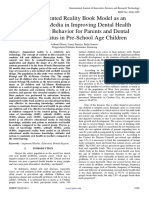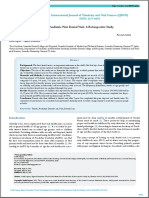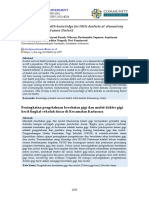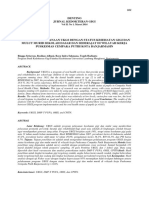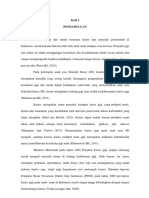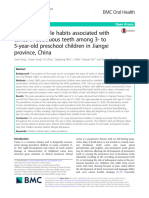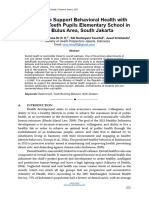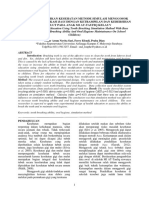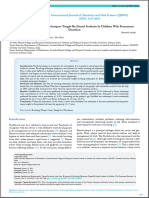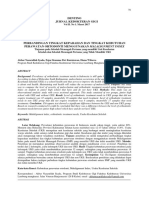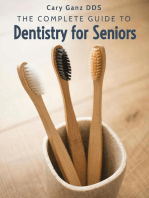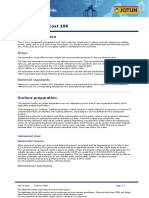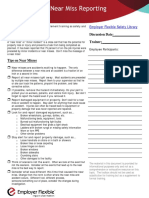Professional Documents
Culture Documents
Development of A Model of Care For Dental and Mouth Health in Toddlers With The Game "Ma'Boy" As An Alternative Change in Mother's Behavior and Formation of Children's Teeth-Brushing Skills
Original Title
Copyright
Available Formats
Share this document
Did you find this document useful?
Is this content inappropriate?
Report this DocumentCopyright:
Available Formats
Development of A Model of Care For Dental and Mouth Health in Toddlers With The Game "Ma'Boy" As An Alternative Change in Mother's Behavior and Formation of Children's Teeth-Brushing Skills
Copyright:
Available Formats
Volume 8, Issue 5, May – 2023 International Journal of Innovative Science and Research Technology
ISSN No:-2456-2165
Development of a Model of Care for Dental and
Mouth Health in Toddlers with the Game “Ma'boy” as
an Alternative Change in Mother's Behavior and
Formation of Children's Teeth-Brushing Skills
Andi Mutia Ramadani Suardi
Postgraduate Poltekkes Kemenkes Semarang
Lanny Sunarjo Suharyo Hadisaputtro
Postgraduate Poltekkes Kemenkes Semarang Postgraduate Poltekkes Kemenkes Semarang
Abstract:- Dental health is important in the life of every I. INTRODUCTION
individual, including children. The 2018 Riskesdas stated
that dental health problems in the 3-4 year old group Dental and oral health is important in the life of every
were 36.4% with the highest distribution in children aged individual, including children, the health of baby teeth is often
three. In children, the role of the mother is very ignored by mothers because they are only considered
important in maintaining dental and oral health. One temporary and will be replaced by permanent teeth. Baby
effort to improve dental and oral health maintenance teeth play an important role in a child's ability to speak and at
behavior is by developing a dental and oral health care the same time help the chewing process which has a good
model which in this study is in the form of a Ma'boy impact on nutrition and child development.(1)The 2018
game. The purpose of this study was to produce a proper Riskesdas results state that 57.6% of the national prevalence
dental and oral health care model and to analyze its rate experienced by Indonesians is dental and oral health
effectiveness in increasing changes in maternal behavior problems.(2)Behavior towards dental and oral health in
and improving toddler's teeth brushing skills. Types of Indonesian society is classified as bad criteria.(3)The results
R&D research, quasy experiment method pre and post- of Riskesdas data from 2013 to 2018 in the description of the
test design (non-equivalent control group). The number of dental caries that occur increase every year
population of toddlers in two Kindergartens assisted by national dental caries in 2013 children aged 1-4 years which is
the Paccerakang Health Center in Makassar city, the 10.4% and in 2018 children aged 3-4 years which is 36.4%
study sample was divided into 2 groups consisting of 17 .(4).(2)
treatment groups and 17 control groups based on
inclusion criteria with the lameshow formula. The The most common type of caries in primary teeth is
research instrument used was a questionnaire. Data rampant caries or more specifically, it is calledECC
analysis was performed by univariate analysis (frequency diseaseearly childhood searches). Caries is often found in
distribution), bivariate analysis (paired samples test and children under five years of age (toddlers), with the highest
independent sample test) and multivariate analysis (linear distribution in children aged three years. There are rampant
regression). The results showed that the development of caries that can cause various problems, especially those
the Ma'boy model had been applied to mothers effectively related to the general health of children who are in the process
increasing knowledge with (p=0.001), an average increase of developing and growing children which can affect the level
of 2.28, attitudes (p=0.008), an average increase of 10.3 of intelligence of children to decrease if allowed to continue
and action (p = 0.000), the average increase is 2.29. In for a long period of time which can have a negative impact on
toddlers, it is effective to improve teeth brushing skills the quality of life of children.(5).(6)Factors that cause ECC or
with (p=0.000), an average increase of 5.81 and decrease non-clinical rampant caries include behavior, environment,
the child's DI score with (p=0.000) an average decrease of heredity, and health services. The behavior of a child in
1.19. The conclusion is that the Ma'boy model of care is maintaining dental and oral hygiene through brushing the
effective in increasing mothers' knowledge, attitudes and child's teeth accompanied by the mother has the potential to
actions as well as teeth brushing skills and reducing DI prevent ECC from occurring compared to a child who brushes
scores in toddlers. his teeth unaccompanied or independently.(7)
Keywords:- Dental Health Care, Mother's Behavior, Tooth brushing behavior in Indonesia has a percentage
Toddler's Teeth Brushing Skills. of 94.7% but for correct tooth brushing behavior is 2.8%.
Meanwhile, tooth brushing behavior in the province of South
Sulawesi shows a rate of 93.6%.(8)This shows that there is a
close relationship with good and correct tooth brushing
IJISRT23MAY759 www.ijisrt.com 1516
Volume 8, Issue 5, May – 2023 International Journal of Innovative Science and Research Technology
ISSN No:-2456-2165
behavior.(9)Instilling a habit of brushing teeth with toothpaste of the child, promotive and preventive evaluation activities are
containing fluoride along with regular visits to the dentist is a currently very much needed in a comprehensive and
very effective method for preventing dental and oral continuous manner. active mother, this activity can be applied
diseases.(10) to the implementation of dental and oral health care.(20).(18)
Several countries have made various efforts to prevent The implementation of dental and oral nursing care
dental and oral diseases in preschool children. Istanbul has (askepgilut) has now been transformed into dental and oral
implemented dental health promotion through an education health care services which have been regulated in the Minister
program for PAUD teachers, but the success rate is still not of Health Law Number 284 of 2006 which explains that
optimal, as only 29.8% of PAUD teachers have knowledge of dental and oral health care is a process of using systematic
oral and dental health.(11)Hong Kong has also implemented methods for the areas of promotion, prevention, and simple
dental and oral health promotion through a fluoridated water curative, several aspects of dental and oral health services,
rinse program (0.5 ppm F), but there has not been any namely assessment, diagnosis, planning, implementation and
significant change in the prevalence of ECC that has been evaluation.(21)Preschoolers or toddlers are not included in the
observed over the last two decades.(12) dental and oral health implementation regulations, the target is
only carried out on individuals or community groups.(22)
Indonesia has carried out a government program, namely
promotive and preventive efforts for toddlers or preschoolers As stated in the Minister of Health Regulation
through the School Dental Health Business (UKGS) (Permenkes) No. 58 of 2012 which describes the
program.(13)The application of the program must be carried implementation of dental nurses, the main duties of dental
out thoroughly so that children are able to have good habits in nurses in carrying out dental and oral health care services for
the activities of daily life.(14)The UKGS program is a individuals, groups and communities on the target of health
program carried out by the government in an effort to services. Permenkes No. 58 of 2012, dental and oral health
maintain and improve oral and dental health for students in care is a planned dental and oral health service, which can be
schools and it is hoped that it will have a positive impact on carried out by the community within a certain period of time,
behavior change in improving dental and oral health and will be carried out continuously in the areas of simple
status.(15) promotive, preventive and curative given to the target
individuals, groups, and society.(23)
Changes in behavior stated that there was a significant
relationship between knowledge, attitudes and behavior of the This research will develop a dental health care model
mother affecting the dental and oral health status of the that is designed for the management of dental and oral health
child.(16)Eating cariogenic foods has been shown to have an care in children aged <5 years (toddlers). The dental health
impact on the occurrence of dental caries in children at care model in question is in the form of a traditional game
Aisyiyah Bustanul Atfal Kindergarten, Lebaksiu Lor Village commonly called Ma'boy. The Ma'boy game is a traditional
(p value = 0.001).(17)From the implementation of the UKGS children's game originating from the Makassar region, South
activity program for toddlers or preschoolers, it can be Sulawesi, which is also commonly called Ma'gebo by the
concluded that the current UKGS program has not been people of South Sulawesi. The noble values in the Ma'boy
successful. The program's failure was influenced by the low game are Cooperation, Solidarity, Accuracy and Accuracy,
dental and oral health maintenance behavior of children from Physical Freshness (sports) Mapping Strategy and Social
the results of the plaque examination index/PHP-M score of Interaction. Thus, a child will be motivated to return to
42, which means that it is not good and the prevalence value learning through traditional children's game learning strategies
of dental caries is 90.1%.(13) (Bugis Makassar).27.
According to SOR theory, a change in behavior or a Geboor Kasti is a game whose method is similar to
person's reaction is influenced by a stimulus (external baseball (softball) in general. It's just that the way to throw it
stimulation). This theory is based on the assumption that the is not as hard as with a straight throw, but slowly by throwing
cause of a change in behavior depends on the stimulus that it up.This Gebo' game uses a baseball to throw the body of
communicates with the organism.(18)Tedi's Behavior Change the target person. There are no fixed rules in this game.
theory is a theory of the formation of preschool children's Because those who get the baseball can throw the target they
teeth brushing behavior which takes only 10 days.(13)Social want. Each player who hits the ball runs around the post and
Learning Theory environment is a place where a person then returns to its original place.
shapes and influences his behavior, the environment does
shape behavior but behavior also forms an environment where The learning strategy based on the Makassar Bugis
there is a relationship/interaction between the environment, traditional game "Ma'boy" is an alternative that can improve
behavior and one's psychological processes.(19),(18) children's explanation abilities, can be actively used as a
solution to problems that occur and can be used as a guide in
Based on the combination of the above theories, the innovating, especially in implementing learning strategies28.
roles of mothers and teachers play an active role in the
formation of stimuli that can be done through learning media The development of a model of dental and oral health
and games. Low knowledge will affect the behavior of the care aims to improve the skills of toddlers in brushing their
mother in maintaining the cleanliness of the teeth and mouth teeth properly, prevent rampant caries, and change the
IJISRT23MAY759 www.ijisrt.com 1517
Volume 8, Issue 5, May – 2023 International Journal of Innovative Science and Research Technology
ISSN No:-2456-2165
behavior of mothers in dental and oral health care and teach Table 1 shows that the child respondents in the
mothers not to get used to unhealthy snacks by making non- intervention group consisted of 7 (41%) male and 10 (59%)
cariogenic food innovations. in order to maintain a child's diet female. In the control group, 6 (35%) were male and 11
that is excessive in consuming cariogenic foods. Based on the (65%) were female. Most of the mothers in the intervention
background above, this research was conducted to identify the and control groups had a bachelor's degree, while the mothers
effectiveness of the dental health care model for the formation in the intervention and control groups were dominated by
of proper tooth brushing behavior and changes in mother's >30 years of age.
behavior on the dental health status of toddlers
Distribution of Research Variable Frequency
II. MATERIALS AND METHODS
Table 2. Frequency Distribution of Research Variables
The type of research is R&D, quasy experiment method Variable Intervention Control
pre and post-test design (non-equivalent control group). The Group Group
population of toddlers in two Kindergartens assisted by the Knowledge Pre-test 6.00 + 1.32 3.41 + 0.93
Paccerakang Health Center in Makassar city, the study sample Post-test 8.82 + 1.01 5.41 + 0.87
was divided into 2 groups consisting of 17 treatment groups Difference 2.82 2
and 17 control groups based on inclusion criteria with the Attitude Pre-test 23.5 + 3.53 16.2 + 1.78
lameshow formula. The research instrument used was a Post-test 33.8 + 3.50 23.2 + 2.16
questionnaire. Data analysis was performed by univariate Difference 10.3 7
analysis (frequency distribution), bivariate analysis (paired Action Pre-test 6.17 + 1.13 5.29 + 1.21
samples test and independent sample test) and multivariate Post-test 8.29 + 1.15 6.47 + 1.06
analysis (linear regressio Difference 2.12 1.18
Tooth Pre-test 6.29 + 0.91 4.47 + 0.94
III. RESULTS AND DISCUSSION
brushing skills
Post-test 12.1 + 1.21 6.11 + 0.85
The results of the research carried out consisted of five
Difference 5.81 1.64
stages including information gathering, model design, expert
validation and revision tests, model trials and model results. DI (Debris Pre-test 2.29 + 0.51 2.47 + 0.24
This research has been carried out and registered with the Index)
HEALTH RESEARCH ETHICS COMMITTEE of the Post-test 1.10+ 0.21 2.11 + 0.55
POLTEKKES KEMENKES SEMARANG with Ethical Difference 1.19 0.36
Clearance number No. 0717/EA/KEPK/2022 This research
was conducted in Makassar City which began in January Table 2 shows the mean value of knowledge in the
2022. intervention group increased from 6.00 to 8.82 and for the
control group increased from 3.41 to 5.41. The mean value of
A. Univariate analysis the mother's attitude in the intervention group increased from
The results of the characteristics in the study are used to 23.5 to 33.8 and for the control group from 16.2 to 23.2. The
find out the general description of the respondents which mean value of the action in the intervention group increased
are presented in the following table: from 6.17 to 8.29 and for the control group increased from
5.29 to 6.47. The mean value of tooth brushing skills in the
Table 1. Characteristics of Research Respondents intervention group increased from 6.29 to 12.1 and for the
No Characteristics Intervention Control control group it increased from 4.47 to 6.11. The mean debris
Group Group index score in the intervention group decreased from 2.29 to
N % N % 1.10 and for the control group decreased from 2.47 to 2.11
1 Gender of child The results of the different test with ANOVA showed that all
variables with a P-value > 0.05,
Man 7 41 6 35
Woman 10 59 11 65
B. Bivariate Analysis
Total 17 100 17 100
Bivariate analysis was carried out to test the differences
2 Mother's Education
between the two variables, in the early stages of model
SD 0 0 0 0 testing carried out in the following way: Normality test, then
JUNIOR HIGH 5 29 4 23 tested the effectiveness of paired and unpaired variables.
SCHOOL
SENIOR HIGH 5 29 6 35 Normality test
SCHOOL The normality test is a test that aims to determine
Bachelor 7 42 7 42 whether the data collected on each variable is normally
Total 17 100 17 100 distributed or not. The normality test used the Shapiro-Wilk
3 Mother's Age method because the number of samples in this study was less
20-30 years 8 47 7 41 than 50 samples.
>30 years 9 53 10 59
Total 17 100 17 100
IJISRT23MAY759 www.ijisrt.com 1518
Volume 8, Issue 5, May – 2023 International Journal of Innovative Science and Research Technology
ISSN No:-2456-2165
Table 3 Shapiro-Wilk Normality Test Results Mean ±SD
Variable p-values Pre-post test
Intervention Control Intervention 2.82 ± 1.34 0.007
Pre-test knowledge 0.488 0.148 Control 2.00 ± 0.57
Post-test knowledge 0.580 0.584 *Paired Samples Test **Independent Sample Test
pre-test attitude 0.584 0.488
Post-test attitude 0.401 0.213 The results of the pair data effectiveness test on
Pre-test action 0.588 0.111 mother's knowledge showed that the P-value of the
Post-test action 0.504 0.129 intervention group was 0.000 (p <0.05) so that the
Tooth brushing skills 0.447 0.219 development of dental and oral health care models was
pre-test effective in increasing knowledge. The p-value of the control
Post-test teeth 0.584 0.147 group's knowledge was 0.011 (P<0.05) meaning that the
brushing skills dental and oral health care model was effective in increasing
DI pre-test 0.401 0.213 the value of mother's knowledge.
IN post-test 0.588 0.111
The results of the effectiveness test for unpaired data on
Based on the results of the data normality test in table 3 the variable knowledge of the pretest data between the
it shows that for pre-post test knowledge, pre-post test intervention group and the control group were significantly
attitudes, pre-post test actions, pre-post test skills and DI pre- different, the p-value was 0.002 (p <0.05), while for the post-
post test in the intervention group normally distributed with a test data the intervention and control groups were
p-value > 0.05, for the control group the pre-post test significantly different, the p-value was 0.001 ( p<0.05) means
knowledge, pre-post test attitude, pre-post test action, pre- that the development of a dental and oral health care model is
post test skills and DI pre-post test in the control group were effective in increasing mother's knowledge compared to the
also normally distributed with a p-value > 0. 05. So the care used in the control group. This is evidenced by an
statistical test used is the parametric test. increase in the average value after being treated in the
intervention group better than the control group, namely the
Model Effectiveness Test intervention group became 8.82 while the control group
Hypothesis testing in research with a pre-post test became 5.41.
design and using controls is considered significant if it meets
one of the following criteria: Unpaired data test results pre-post delta (Δ) different
meaning, it can be seen that the p-value is 0.007 (p <0.05)
If the results of the paired test in the intervention group
meaning that the development of a model of dental and oral
are significant (p<0.05) while those in the control group
health care is effective in increasing mother's knowledge in
are not significant (p>0.05) and the results in the
implementing child dental and oral health care compared to
intervention group are better than the control.
parenting used in the control group. This is evidenced by an
If the test results were not paired, the pre-test data
increase in the average value after being treated in the
between the intervention group and the control group
intervention group better than the control group, namely the
were not significantly different (p>0.05), but the post-test
intervention group became 2.82 while the control group
data between the intervention group and the control group
became 2.00.
were significantly different (p <0.05) and the results on
the intervention group was better than the control group.
Table 5 Test of the Effectiveness of Mother's Attitudes in the
If the test results are unpaired, the delta data (∆) between Intervention and Control Groups
the intervention group and the control group is
Measurement Pre-test Post-test p-
significantly different (p <0.05) and the results in the
time Mean ±SD Mean values
control group are better than the intervention group.
±SD
Paired Data Test
Following are the results of testing the effectiveness of
Intervention 23.5 + 3.53 33.8 + 0.001
the model in the intervention group and the control group:
3.50
Table 4. Test of the Effectiveness of Mother's Knowledge in Control 16.2 + 1.78 23.2 + 0.025
the Intervention and Control Groups 2.16
Measurement Pre-test Post-test p-values Unpaired Data Test
time Mean ±SD Mean ±SD Intervention 23.5 + 3.53 33.8 +
Paired Data Test 3.50
Intervention 6.00 + 1.32 8.82 + 1.01 0.000 Control 16.2 + 1.78 23.2 +
2.16
Control 3.41 + 0.93 5.41 + 0.87 0.011
p-values 0.045 0.012
Unpaired Data Test
Unpaired Data Test Change Value (∆)**
Intervention 6.00 + 1.32 8.82 + 1.01
Mean ±SD Pre-post test
Control 3.41 + 0.93 5.41 + 0.87
Intervention 10.3 ± 5.152 0.008
p-values 0.002 0.001
Control 7.00 ± 6.913
Unpaired Data Test Change Value (∆)**
*Paired Samples Test **Independent Sample Test
IJISRT23MAY759 www.ijisrt.com 1519
Volume 8, Issue 5, May – 2023 International Journal of Innovative Science and Research Technology
ISSN No:-2456-2165
The results of the effectiveness test on paired data on The results of the effectiveness test of unpaired data on
mother's attitudes showed that the p-value of the intervention the action variable pre-test data between the intervention
group was 0.001 (p <0.05). The p-value of the control group's group and the control group were significantly different, the
knowledge was 0.025 (P<0.05) meaning that the dental and p-value was 0.007 (p <0.05), while for the post-test data the
oral health care model was effective in increasing the value intervention and control groups were significantly different,
of the mother's attitude. the p-value was 0.001 (p<0.05) means that the development
of a dental and oral health care model is effective in
The results of the effectiveness test of the unpaired data increasing the mother's actions compared to the care used in
on the attitude variable on the pre-test data between the the control group. This is evidenced by an increase in the
intervention group and the control group were significantly average value after being treated in the intervention group
different, the p-value was 0.042 (p <0.05), while for the post- better than the control group, namely the intervention group
test data the intervention and control groups were became 8.29 while the control group became 6.47.
significantly different, the p-value was 0.000 (p<0.05) means
that the development of a dental and oral health care model is Unpaired data test results pre-post delta (Δ) value has a
effective in improving the mother's attitude compared to the different meaning, it can be seen that the p-value is 0.000 (p
care used in the control group. This is evidenced by an <0.05) meaning that the development of a model of dental
increase in the average value after being treated in the and oral health care is effective in increasing the mother's
intervention group better than the control group, namely the actions in implementing child dental and oral health care
intervention group became 33.8 while the control group compared to parenting used in the control group. This is
became 23.2. evidenced by an increase in the average value after being
treated in the intervention group better than the control
The results of the unpaired data test the pre-post delta group, namely the intervention group became 2.29 while the
(Δ) value has a different meaning, it can be seen that the p- control group became 1.18.
value is 0.008 (p <0.05) meaning that the development of a
model of dental and oral health care is effective in increasing Table 7 Effectiveness Test of Teeth Brushing Skills in the
the mother's attitude in implementing child dental and oral Intervention and Control Groups
health care compared to parenting used in the control group. Measurement Pre-test Post-test p-
This is evidenced by an increase in the average value after time Mean ±SD Mean values
being treated in the intervention group better than the control ±SD
group, namely the intervention group became 10.3 while the Paired Data Test
control group became 7.00. Intervention 6.29 + 0.91 12.1 + 0.000
1.21
Table 6 Test of the Effectiveness of Mother's Actions in the Control 4.47 + 0.94 6.11 + 0.001
Intervention and Control Groups 0.85
Measurement Pre-test Post-test p- Unpaired Data Test
time Mean ±SD Mean values Intervention 6.29 + 0.91 12.1 +
±SD 1.21
Paired Data Test Control 4.47 + 0.94 6.11 +
Intervention 6.17 + 1.13 8.29 + 0.000 0.85
1.15 p-values 0.007 0.001
Control 5.29 + 1.21 6.47 + 0.018 Unpaired Data Test Change Value (∆)**
1.06 Mean ±SD
Unpaired Data Test Pre-post test
Intervention 6.17 + 1.13 8.29 + Intervention 5.81 ± 5.551 0.000
1.15 Control 1.64 ± 4.062
Control 5.29 + 1.21 6.47 + *Paired Samples Test **Independent Sample Test
1.06
p-values 0.007 0.001 The results of the effectiveness test of paired data on
Unpaired Data Test Change Value (∆)** tooth brushing skills showed that the p-value of the
Mean ±SD intervention group was 0.000 (p <0.05) so that the
Pre-post test development of dental and oral health care models was
Intervention 2.29 ± 2.775 0.000 effective in improving children's tooth brushing skills. The p-
Control 1.18 ± 3.878 value of the control group's knowledge was 0.001 (P<0.05)
*Paired Samples Test **Independent Sample Test meaning that the dental and oral health care model was
effective in increasing the value of children's teeth brushing
The results of the effectiveness test on paired data on skills.
mother's actions showed that the p-value of the intervention
group was 0.000 (p <0.05). The p-value of the control group's The results of the effectiveness test for the unpaired
knowledge was 0.018 (P<0.05) meaning that the dental and data on the tooth brushing skills variable, the pre-test data
oral health care model was effective in increasing the value between the intervention group and the control group, were
of the mother's actions. significantly different, the p-value was 0.001 (p <0.05), while
IJISRT23MAY759 www.ijisrt.com 1520
Volume 8, Issue 5, May – 2023 International Journal of Innovative Science and Research Technology
ISSN No:-2456-2165
the post-test data for the intervention and control groups were The results of the unpaired data test the pre-post delta
significantly different, the p-value was significant. value is (Δ) value has a different meaning, it can be seen that the p-
0.000 (p<0.05) meaning that the development of a dental and value is 0.000 (p <0.05) meaning that the development of a
oral health care model is effective in improving children's dental and oral health care model is effective in reducing the
teeth brushing skills compared to the care used in the control child's DI score in the implementation of children's dental
group. This is evidenced by an increase in the average value and oral health care compared to care used in the control
after being treated in the intervention group better than the group. This is evidenced by the decrease in the average value
control group, namely the intervention group became 12.1 after being treated in the intervention group better than the
while the control group became 6.11. control group, namely the intervention group became 1.19
while the control group became 0.36.
The results of the unpaired data test the pre-post delta
(Δ) value has a different meaning, it can be seen that the p- Confounding variable on behavioral improvement in oral
value is 0.000 (p <0.05). with the care used in the control health
group. This is evidenced by an increase in the average value The intervention model of dental and oral health care in
after being treated in the intervention group better than the toddlers needs to consider other variables that interfere with
control group, namely the intervention group became 5.81 the results or are commonly called confounding variables, in
while the control group became 1.64. this study the confounding variables were mother's education
and age.
Table 8 DI Effectiveness Test in the Intervention and Control
Groups Table 9 Variables of Mother's Education and Age on
Measurement Pre-test Post-test p-values Increasing Mother's Behavior in Toddler Dental and Oral
time Mean ±SD Mean Health.
±SD Variable p-values
Paired Data Test Mother's education 0.585
Intervention 2.29 + 0.51 1.10 + 0.000 Mother's age 0.676
0.21
Control 2.47 + 0.24 2.11 + 0.001 Based on table 9 it can be seen that there are no other
0.55 variables related to the independent variable or the dependent
Unpaired Data Test variable, where the education and mother's age variables have
Intervention 2.29 + 0.51 1.10 + a value of p> (0.05).
0.21
Control 2.47 + 0.24 2.11 + C. Dental and Oral Health Care Model for Toddlers
0.55 The dental and oral nursing care program is one of the
P-values 0.001 0.001 efforts to address dental and oral health problems. The aim of
Unpaired Data Test Change Value (∆)** dental and oral nursing care services is to improve the ability
Mean ±SD to maintain oneself in the field of dental and oral health, as
Pre-post test well as optimal dental and oral health status. The target of
Intervention 1.19 ± 1.551 0.000 dental and oral health care services is prioritized for groups
Control 0.36 ± 0.462 that are vulnerable to dental and oral diseases including early
*Paired Samples Test **Independent Sample Test childhood (pre-school) whose dental and oral health cannot be
ignored, because it also influences the perfect child's growth
Based on table 8, it shows that the results of the pair and development29.
data effectiveness test have a p-value for the intervention
group of 0.000 (p-<0.05) meaning that the development of a The results of gathering information obtained that in
dental and oral health care model for toddlers with Ma boy is forming children's teeth brushing skills from an early age it is
effective in reducing toddler index debris. The p-value of the necessary to provide educational methods that are right on
control group was 0.001 (P<0.05) meaning that the dental target and supported by media that developed in the industrial
phantom trainer reduced the toddler index debris. revolution era 4.0, in accordance with the results of previous
research that the provision of educational methods with the
The results of the effectiveness test of the unpaired data right stimulus and response for growth and child development
of the DI variable in the pre-test data between the can affect changes in child behavior. Children's education
intervention group and the control group were significantly from an early age is obtained directly from the mother and the
different. 0.001 (p<0.05) means that the development of a role of the mother in the child's development period is very
dental and oral health care model is effective in reducing large, starting from dental health, dental hygiene, to children's
children's DI scores compared to the care used in the control dental and oral diseases. Preschool children are very
group. This is evidenced by the decrease in the average value vulnerable to dental and oral health, so special attention is
after being treated in the intervention group better than the needed and the role of the mother in maintaining the
control group, namely the intervention group became 1.10 cleanliness of the child's teeth and mouth,30.
while the control group became 2.11.
IJISRT23MAY759 www.ijisrt.com 1521
Volume 8, Issue 5, May – 2023 International Journal of Innovative Science and Research Technology
ISSN No:-2456-2165
The formation of independence in brushing teeth in children, mother's awareness of the importance of children's
children apart from providing education should also use dental health can be seen from the knowledge they have. A
learning methods that attract children's attention so that cause of dental and oral health problems in children is a
children do not get bored quickly while studying and learning behavioral factor that ignores dental and oral hygiene32.
becomes part of the fun for children in the form of Ma'Boy
game media. Ma'boy” is a traditional children's game The development of dental and oral health care for
originating from Makassar, South Sulawesi. The Ma'boy toddlers is a modification of dental and oral health care
game is also commonly called Ma'gebo by the people of (askepgitut) that uses the theory of tedi's behavior change and
South Sulawesi. The noble values in the Ma'boy game are the theory of health belief model which aims to change the
Cooperation, Solidarity, Accuracy and Accuracy, Physical behavior of mothers on dental and oral health for toddlers, the
Freshness (sports) Mapping Strategy and Social Interaction. formation of children's skills in brushing their teeth and
Thus, students are motivated to return to learning through providing intake of healthy children as a support for good
strategies. Learning traditional children's games (Bugis dental and oral hygiene status33.
Makassar)27.
Knowledge is one of the factors associated with the
Geboor Kasti is a game whose method is similar to incidence of caries in toddlers. Knowledge will underlie the
baseball (softball) in general. It's just that the way to throw it formation of behavior that supports or does not support
is not as hard as with a straight throw, but slowly by throwing children's dental and oral hygiene. This knowledge can be
it up.This Gebo' game uses a baseball to throw the body of the obtained naturally or in a planned manner, namely through the
target person. There are no fixed rules in this game. Because educational process. Mothers with knowledge of dental and
those who get the baseball can throw the target they oral hygiene are predisposing factors for behavior that does
want.Each player who hits the ball runs around the post and not support dental and oral hygiene(24). The results of the
then returns to its original place. expert validation showed a p-value of 0.003, which means
that the dental and oral health care model for toddlers is
Toddlers are children aged 1-5 years divided into two, relevant as a dental and oral health care model for toddlers.
namely children over three years who are known as "batita" Expert validation is also referred to as the process of content
and children over three years to five years who are called validity where a module is said to be valid based on the
"preschool" age. Preschoolers are children in the age group validity of the module content carried out by expert judgment
above one year or under five years. In this age period toddlers (assessments made by experts).
start to learn a lot to interact with the social environment
outside the family and children will get to know many new D. Product/Model Trial
things that have not been done before31.
Toddler
Children aged under five are very susceptible to The results of the effectiveness test for the unpaired data
experiencing problems with dental and oral health. Toddlers on the tooth brushing skills variable, the pre-test data between
are referred to in the preschool age group who are vulnerable the intervention group and the control group, were
to rampant caries or early childhood caries, because toddlers significantly different, the p-value was 0.001 (p <0.05), while
cannot do many things by themselves, including toddlers who the post-test data for the intervention and control groups were
cannot maintain dental hygiene independently but must significantly different, the p-value was significant. value is
accompanied by mother31. 0.000 (p<0.05) meaning that the development of a dental and
oral health care model is effective in improving children's
There are many factors that cause dental and oral health teeth brushing skills compared to the care used in the control
problems in toddlers which include internal factors, children group. This is evidenced by an increase in the average value
aged under five really like to eat sweet foods that contain after being treated in the intervention group better than the
excessive sucrose causing damage to the lining of the child's control group, namely the intervention group became 12.1
teeth, children who like to chew food, this habit can damage while the control group became 6.11.
teeth and can reduce tooth decay. the amount of nutritional
intake, drinking milk with a pacifier bottle until the child falls The therapist at the first meeting approaches the patient,
asleep, the remaining milk that sticks to the surface of the the second meeting still builds relationships with the patient
child will become acidic so that bacteria will develop causing and performs intraoral and extra oral examinations. The
damage to the teeth. External factors, namely age, simulation method can be interpreted as a way of presenting
environment, parental behavior, and the economy can also be learning experiences by using artificial situations to
a cause of dental and oral health problems in children32. understand certain concepts, principles or actions. Meetings 2
and 3 carried out observations on the ability of toddlers to
The role of mother to child in the world of dental health brush their teeth as well as dental and oral health checks for
is also very important. Factors that cause tooth decay in toddlers and training in brushing their teeth with the ma boy
toddlers affect the mother's role in addition to nutritional game. Then for the 3rd meeting the intervention was in the
intake and behavior, mothers who do not have much form of brushing teeth for toddlers in accordance with the
knowledge, attitudes, and actions regarding dental and oral guidelines for developing dental and oral health care models
health greatly affect the child's oral hygiene status. The level for toddler mothers. The 3rd meeting observed the ability of
of awareness of mothers who do not support dental health in toddlers to clean the oral cavity in the third week after the
IJISRT23MAY759 www.ijisrt.com 1522
Volume 8, Issue 5, May – 2023 International Journal of Innovative Science and Research Technology
ISSN No:-2456-2165
training was carried out. For the 4th meeting post-test and Knowledge is an important condition in forming
evaluation attitudes to maintain healthy teeth. Good knowledge will have
an impact on the behavior of caring for good dental and oral
This is evidenced by an increase in the average value health as well. Proper and correct tooth brushing counseling
after being treated in the intervention group better than the are efforts made to change the behavior of a person, group of
control group, namely the intervention group became 12.1 people or society so that they have knowledge, attitudes and
while the control group became 6.11. The application of habits to behave in a healthy life in the field of dental and oral
dental and oral health care services that are given directly by health, namely maintenance of good and correct dental
showing how to do or do something, so that learning becomes health.(27). Someone who has increased knowledge will be
clearer and more concrete and it is easier for respondents to supportive and will be reflected in the form of better actions
understand what is being learned. The implementation of or behavior. Changes in knowledge are initiated by a person's
dental and oral health care services focuses the attention of perception of what will be lived, so that perceptions appear
respondents on things that are considered important by the according to the information obtained(28).
teacher so that important things can be observed carefully(25).
Guiding students towards thinking the same in the same IV. CONCLUSION
channel of thought. So that learning is more acceptable and
absorbed by respondents34. Based on the results of the study, it can be concluded
that the Ma'boy dental and oral health care model is
E. Mother of Toddlers appropriate and its application is effective in changing the
The results showed that the application of dental and oral behavior of toddler mothers and improving teeth brushing
health care for toddlers can increase the mother's knowledge, skills in toddlers by playing ma boy.
attitudes and actions. Unpaired data test results pre-post delta The Ma'boy toddler oral health care model is effective in
(Δ) different meaning, it can be seen that the p-value is 0.001 increasing:
(p <0.05) meaning that the development of a dental and oral The Ma'boy toddler oral health care model is effective in
health care model is effective in increasing mother's increasing the mother's knowledge as proven by the p-
knowledge in the implementation of child dental and oral value = 0.001. This is evidenced by an increase in the
health care compared to oral health care. used in the control average value after being treated in the intervention group
group. This is evidenced by an increase in the average value better than the control group, namely the intervention
after being treated in the intervention group better than the group became 2.82 while the control group became 2.00.
control group, namely the intervention group became 8.21 Ma'boy's dental and oral health care model is effective in
while the control group became 5.19. increasing the mother's attitude as proven by the p-value
= 0.008. This is evidenced by an increase in the average
The results of the unpaired data test the pre-post delta value after being treated in the intervention group better
(Δ) value has a different meaning, it can be seen that the p- than the control group, namely the intervention group
value is 0.008 (p <0.05) meaning that the development of a became 10.3 while the control group became 7.00.
model of dental and oral health care is effective in increasing The Ma'boy toddler oral health care model is effective in
the mother's attitude in implementing child dental and oral increasing the mother's actions as proven by the p-value =
health care compared to parenting used in the control group. 0.000. This is evidenced by an increase in the average
This is evidenced by an increase in the average value after value after being treated in the intervention group better
being treated in the intervention group better than the control than the control group, namely the intervention group
group, namely the intervention group became 6.05 while the became 2.29 while the control group became 1.18.
control group became 1.93. The Ma'boy toddler oral health care model is effective in
improving toddlers' teeth brushing skills as proven by the
Unpaired data test results pre-post delta (Δ) value has a p-value = 0.000. This is evidenced by an increase in the
different meaning, it can be seen that the p-value is 0.000 (p average value after being treated in the intervention group
<0.05) meaning that the development of a model of dental and better than the control group, namely the intervention
oral health care is effective in increasing the mother's actions group became 5.81 while the control group became 1.64.
in implementing child dental and oral health care compared to The dental and oral health care model for toddlers Ma'boy
parenting used in the control group. This is evidenced by an is effective in reducing DI scores for toddlers as proven
increase in the average value after being given treatment in by the p-value = 0.000. This is evidenced by the decrease
the intervention group better than the control group, namely in the average value after being treated in the intervention
the intervention group became 3.60 while the control group group better than the control group, namely the
became 0.91. intervention group became 1.19 while the control group
became 0.36
Behavior (knowledge) towards maintaining oral health
can cause dental caries. Knowledge/insight of parents is very
influential on the dental health of their children. Mothers who
want to expand their knowledge/insight (cooperative) more
often have cooperative children, in other words, mothers who
have good knowledge, their children's teeth will also be
good/healthy(26).
IJISRT23MAY759 www.ijisrt.com 1523
Volume 8, Issue 5, May – 2023 International Journal of Innovative Science and Research Technology
ISSN No:-2456-2165
REFERENCES [17]. Maulida S, L GS, Oktiawati A. Faktor-faktor yang
berhubungan dengan kejadian karies gigi pada anak di
[1]. Delima AR, Riyadi NA, Maulani C. Upaya TK Aisyiyah Bustanul Atfal Desa Lebaksiu Lor. J
Meningkatkan Pengetahuan dan Keterampilan Ibu Keperawatan Anak. 2014;
Mengenai Kesehatan Gigi dan Mulut Balita. JPPM [18]. Adventus, Jaya IMJ, Mahendra D. Buku Ajar Promosi
(Jurnal Pengabdi dan Pemberdaya Masyarakat). Kesehatan. Universitas Kristen Indonesia. 2019.
2018;2(2):245. [19]. Crain W. Bandura’s Social Learning Theory. In:
[2]. Badan Penelitian dan Pengembangan. Badan Penelitian Theories of Development: Concepts and Applications.
dan Pengembangan Kesehatan. Kementrian Kesehat 2021.
Republik Indones. 2018; [20]. Fitriana A, Kasuma N. Gambaran Tingkat Kesehatan
[3]. Pusat Data dan Informasi Kementrian Kesehatan RI. Gigi Anak Usia Dini Berdasarkan Indeks Def-T Pada
Data dan Informasi Profil Kesehatan Indonesia 2015. Siswa Paud Kelurahan Jati Kota Padang. Andalas Dent
Kementrian Kesehatan RI. 2015. J. 2019;
[4]. Badan Penelitian dan Pengembangan Kesehatan. Riset [21]. Kepmnekes RI. Permenkes No.284 Tahun 2006. 2006;
Kesehatan Dasar (RISKESDAS) 2013. Lap Nas 2013. [22]. Siregar IHY, Wahyati Y E, Widyarto JS. D.
2013; Perlindungan Hukum Bagi Perawat Gigi Dalam
[5]. Mariati NW. Pencegahan Dan Perawatan Karies Melakukan Pelayanan Asuhan Kesehatan Gigi Di
Rampan. J BIOMEDIK. 2015; Praktik Mandiri. SOEPRA. 2018;
[6]. Setiari LS, Sulistyowati M. Tindakan Pencegahan [23]. Permenkes, R I. Penyelenggaraan Pekerjaan Perawat
Karies Gigi Pada Siswa Sekolah Dasar Berdasarkan Gigi. In: Direktorat Jedral Pelayanan Medik Direktorat
Teori Health Belief Model. J PROMKES. 2018; Kesehatan Gigi. jakarta; 2012. p. 1–15.
[7]. Andriani. Hubungan Periaku Ibu dalam Pemeliharaan [24]. Suryaningtyas F, Hidayati S, Mahirawatie IC. SLR :
Kebersihan Gigi dan Mulut dengan Status Kebersihan Peran Orang Tua dalam Memelihara Kesehatan Gigi
Gigi dan Mulut pada Anak di SD N Lamsayuen Kab dan Mulut dengan Kejadian Karies. J Ilm Keperawatan
Aceh Besar. J Mutiara Kesehat Masy. 2019;4(1):17–24. Gigi. 2022;3(1):88–98.
[8]. Kemenkes Kesehatan Republik Indonesia. Laporan [25]. S. B. AD, Zain. Strategi Belajar Mengajar. Bandung
Riset Kesehatan Dasar (Riskesdas) Nasional 2018. CV Maulana. 2001;
Badan Penelitian dan Pengembangan Kesehatan [26]. Rakhmawati NS, Budiono I, Rustiana ER, Subekti A.
Kementerian Kesehatan RI. 2018. Adolescents’ Personal Autonomy And Intentions On
[9]. Vieira AR, Hilands KM, Braun TW. Saving more Dental And Oral Health Maintenance Behavior.
teeth—A case for personalized care. J Pers Med. 2015; ODONTO Dent J. 2021;8(2):156–64.
[10]. Nordström A, Birkhed D. Attitudes and behavioural [27]. Saiful S. Konsep dan Makna Pembelajaran: Untuk
factors relating to toothbrushing and the use of fluoride Membantu Memecahkan Problematika Belajar dan
toothpaste among caries-active Swedish adolescents–a Mengajar, cet IV. Bandung: Alfabeta. 2006.
questionnaire study. Acta Odontol Scand. 2017; [28]. Notoatmodjo S. Promosi Kesehatan, Teori & Aplikasi,
[11]. Baltacı E, Baygın Ö, Tüzüner T, Korkmaz FM. ed. revisi 2010. Jakarta: Rineka Cipta. 2010.
Evaluation of the knowledge, attitudes and behaviors of
pre-school teachers on oral and dental health in the city
center of Trabzon. Eur Oral Res. 2019;
[12]. Chen KJ, Gao SS, Duangthip D, Lo ECM, Chu CH.
Early childhood caries and oral health care of Hong
Kong preschool children. Clin Cosmet Investig Dent.
2019;
[13]. Purnama T, Rasipin R, Santoso B. Pengaruh Pelatihan
Tedi’s Behavior Change Model pada Guru dan Orang
Tua terhadap Keterampilan Menggosok Gigi Anak
Prasekolah. Qual J Kesehat. 2019;
[14]. Rieza Zulfahmi Taftazani, Lina Rismayani BST.
Analisis Program Kegiatan Usaha Kesehatan Gigi
Sekolah (Ukgs) Di Puskesmas Halmahera. J Jesehat
Gigi. 2015;
[15]. Taormina M, Montal S, Maitre Y, Tramini P, Moulis E.
Perception of dental caries and parental difficulties in
implementing oral hygiene for children aged less than 6
years: A qualitative study. Dent J. 2020;
[16]. Zia HK, Nurhamidah N, Afriza D. Hubungan
Pengetahuan, Sikap Dan Perilaku Ibu Terhadap
Kebiasaan Menyikat Gigi Anak. B-Dent, J Kedokt Gigi
Univ Baiturrahmah. 2018;
IJISRT23MAY759 www.ijisrt.com 1524
You might also like
- Keywords:-Data Collection and Evaluation, UKGSDocument11 pagesKeywords:-Data Collection and Evaluation, UKGSInternational Journal of Innovative Science and Research TechnologyNo ratings yet
- Universitas Abulyatama Jurnal Aceh MedikaDocument11 pagesUniversitas Abulyatama Jurnal Aceh MedikaNabilNo ratings yet
- No+3 +244Document7 pagesNo+3 +244Salma WorldNo ratings yet
- The Augmented Reality Book Model As An Educational Media in Improving Dental Health Maintenance Behavior For Parents and Dental Hygiene Status in Pre-School Age ChildrenDocument21 pagesThe Augmented Reality Book Model As An Educational Media in Improving Dental Health Maintenance Behavior For Parents and Dental Hygiene Status in Pre-School Age ChildrenInternational Journal of Innovative Science and Research TechnologyNo ratings yet
- Ejpd 2018 19 3 3Document6 pagesEjpd 2018 19 3 3Javier Cabanillas ArteagaNo ratings yet
- Knowledge, Attitude and Practices On Oral Health of Public School Children of Batangas CityDocument10 pagesKnowledge, Attitude and Practices On Oral Health of Public School Children of Batangas CityAsia Pacific Journal of Multidisciplinary ResearchNo ratings yet
- Apjmr 2014 2 111 PDFDocument10 pagesApjmr 2014 2 111 PDFJohnree A. EvangelistaNo ratings yet
- Smart Toothbrush As An Educational Medium To Improve The Toothbrushing Skills of Blind ChildrenDocument8 pagesSmart Toothbrush As An Educational Medium To Improve The Toothbrushing Skills of Blind ChildrenInternational Journal of Innovative Science and Research TechnologyNo ratings yet
- 626 1453 1 SMDocument6 pages626 1453 1 SMSania handayaniNo ratings yet
- Geographic Information System of Dental Caries Management (Sig-Mkg) To Improve The Quality of Information in Dental and Oral Health Services in PuskesmasDocument6 pagesGeographic Information System of Dental Caries Management (Sig-Mkg) To Improve The Quality of Information in Dental and Oral Health Services in PuskesmasInternational Journal of Innovative Science and Research TechnologyNo ratings yet
- ID Penggunaan Komik Kesehatan Gigi Dalam MeDocument10 pagesID Penggunaan Komik Kesehatan Gigi Dalam MeArin Nanda Sekar PalupiNo ratings yet
- 31 CaDocument6 pages31 CaIndra YaniNo ratings yet
- 1186-Article Text-5754-1-10-20221219Document5 pages1186-Article Text-5754-1-10-20221219mushab kartanegaraNo ratings yet
- Bab IDocument6 pagesBab IRetnosari AhmadiNo ratings yet
- Knowledge and Attitude of Dental Hygiene Practice Among Primary 4 - 6 Pupils of Archbishop Peter Akinola International School in Afikpo, Ebonyi StateDocument50 pagesKnowledge and Attitude of Dental Hygiene Practice Among Primary 4 - 6 Pupils of Archbishop Peter Akinola International School in Afikpo, Ebonyi StateSamuel NwachukwuNo ratings yet
- 76-Article Text-404-2-10-20230201Document6 pages76-Article Text-404-2-10-20230201Gita PratamaNo ratings yet
- Trends in Paediatric First Dental Visit A RetrospeDocument6 pagesTrends in Paediatric First Dental Visit A RetrospeData VaksinNo ratings yet
- (Setyaningsih, 2007) .Document7 pages(Setyaningsih, 2007) .AyestinNo ratings yet
- Smart Audio Toothbrush With UV-filtered Toothpaste Dispenser To Improve Skills Brushing Teeth and Reducing Debris Index Blind ChildrenDocument6 pagesSmart Audio Toothbrush With UV-filtered Toothpaste Dispenser To Improve Skills Brushing Teeth and Reducing Debris Index Blind ChildrenInternational Journal of Innovative Science and Research TechnologyNo ratings yet
- Program Studi D-III Refraksi Optisi Universitas Kader Bangsa, IndonesiaDocument10 pagesProgram Studi D-III Refraksi Optisi Universitas Kader Bangsa, IndonesiaYunika Dwi RahmitaNo ratings yet
- 1308-Article Text-5801-1-10-20230203Document11 pages1308-Article Text-5801-1-10-20230203A.Nurfaizah PramudyaNo ratings yet
- Oral Hygiene ProjectDocument8 pagesOral Hygiene Projecttanvirahmed0% (1)
- 6957-Article Text-28026-1-10-20221003Document7 pages6957-Article Text-28026-1-10-20221003Tamara Al KautsarNo ratings yet
- Dental Health Education Promotionusing Video Blogs Vlogand Treatment Methodson Teething Practicesin Basic School Childrenin Bandung CityDocument6 pagesDental Health Education Promotionusing Video Blogs Vlogand Treatment Methodson Teething Practicesin Basic School Childrenin Bandung Cityerfina fuji safitriNo ratings yet
- Jurnal Naomi HutasoitDocument10 pagesJurnal Naomi HutasoitMonica lrNo ratings yet
- Jurnal 10Document11 pagesJurnal 10Atika DelianaNo ratings yet
- Tindakan Pencegahan Karies Gigi Pada Siswa Sekolah PDFDocument12 pagesTindakan Pencegahan Karies Gigi Pada Siswa Sekolah PDFGama AceplusNo ratings yet
- Foreign LiteratureDocument13 pagesForeign LiteratureJm. n BelNo ratings yet
- Dental and Oral Health Education For Elementary School Students Through Patient Hygiene Performance Index IndicatorDocument5 pagesDental and Oral Health Education For Elementary School Students Through Patient Hygiene Performance Index IndicatorrahmahNo ratings yet
- Review On Infant Oral HealthDocument11 pagesReview On Infant Oral HealthIJAR JOURNALNo ratings yet
- Prevention of Dental Caries in Elementary School Students Based On The Theory of Health Belief ModelDocument12 pagesPrevention of Dental Caries in Elementary School Students Based On The Theory of Health Belief ModelAuliya NafisahNo ratings yet
- Oleh Septi Lia Utari 010111A103Document10 pagesOleh Septi Lia Utari 010111A103Abdul MushawirNo ratings yet
- Hubungan Pelaksanaan Ukgs Dengan Status Kesehatan Gigi Dan Mulut Murid Sekolah Dasar Dan Sederajat Di Wilayah Kerja Puskesmas Cempaka Putih Kota Banjarmasin - 2 PDFDocument8 pagesHubungan Pelaksanaan Ukgs Dengan Status Kesehatan Gigi Dan Mulut Murid Sekolah Dasar Dan Sederajat Di Wilayah Kerja Puskesmas Cempaka Putih Kota Banjarmasin - 2 PDFrefdaNo ratings yet
- School Dental Health Programme Pedo 2Document25 pagesSchool Dental Health Programme Pedo 2misdduaaNo ratings yet
- School Health Program As An Educational Facility IDocument5 pagesSchool Health Program As An Educational Facility IKlinik KaninaNo ratings yet
- Pengaruh Peran Orang Tua Tentang Perawatan Gigi Terhadap Terjadinya Karies Gigi Pada Anak Usia 4-6 Tahun Di Wilayah TK Negeri Pembina Batulicin Kecamatan Batulicin Kabupaten Tanah BumbuDocument10 pagesPengaruh Peran Orang Tua Tentang Perawatan Gigi Terhadap Terjadinya Karies Gigi Pada Anak Usia 4-6 Tahun Di Wilayah TK Negeri Pembina Batulicin Kecamatan Batulicin Kabupaten Tanah BumbuAdhitya Julyan ChandraNo ratings yet
- Bab I Pendahuluan A. Latar BelakangDocument5 pagesBab I Pendahuluan A. Latar BelakangGlobalNo ratings yet
- Review of Related Literature Effects of Oral Health Education On Knowledge and PracticesDocument2 pagesReview of Related Literature Effects of Oral Health Education On Knowledge and PracticesADEA Group and PartnersNo ratings yet
- 2553-Article Text-4699-1-10-20200610 PDFDocument6 pages2553-Article Text-4699-1-10-20200610 PDFMeiliansuri Bunga AvishaNo ratings yet
- Prevalence of Dental Caries Among School Going Children in Mixed Dentition Stage (6 To 15 Years of Age) in The Suburbs Schools of Islamabad, PakistanDocument6 pagesPrevalence of Dental Caries Among School Going Children in Mixed Dentition Stage (6 To 15 Years of Age) in The Suburbs Schools of Islamabad, PakistankajdfaskNo ratings yet
- 12470-Article Text-52940-1-10-20231222Document7 pages12470-Article Text-52940-1-10-20231222panduutamidrgNo ratings yet
- Jurnal Dian Syahna Nazella Reviisi-1Document10 pagesJurnal Dian Syahna Nazella Reviisi-1Darwin AllNo ratings yet
- Jurnal Kesehatan Gigi: Perilaku Dan Keterampilan Menyikat Gigi Terhadap Timbulnya Karies Gigi Pada Anak Di Kota JambiDocument7 pagesJurnal Kesehatan Gigi: Perilaku Dan Keterampilan Menyikat Gigi Terhadap Timbulnya Karies Gigi Pada Anak Di Kota JambiUntuk TugasNo ratings yet
- Jurnal 2Document7 pagesJurnal 2vega luyuniNo ratings yet
- Jurnal Kesehatan GigiDocument5 pagesJurnal Kesehatan GigiNur KhofifahNo ratings yet
- ARTIKELDocument18 pagesARTIKELNia DamayatriNo ratings yet
- Impact Evaluation of A School-Based Oral Health Program Kuwait National ProgramDocument9 pagesImpact Evaluation of A School-Based Oral Health Program Kuwait National ProgramLeo AlbertoNo ratings yet
- Diet and Lifestyle Habits Associated With Caries in Deciduous Teeth Among 3-To 5-Year-Old Preschool Children in Jiangxi Province, ChinaDocument9 pagesDiet and Lifestyle Habits Associated With Caries in Deciduous Teeth Among 3-To 5-Year-Old Preschool Children in Jiangxi Province, Chinaandres.ft12345No ratings yet
- Jcs 8 105Document6 pagesJcs 8 105nadia syestiNo ratings yet
- Long Term Effectiveness of The Midwifery Initiated Oral Health Dental Service Program On Maternal Oral Health Knowledge Preventative DentalDocument13 pagesLong Term Effectiveness of The Midwifery Initiated Oral Health Dental Service Program On Maternal Oral Health Knowledge Preventative DentalGita PratamaNo ratings yet
- 443-Article Text-1394-2-10-20220323Document12 pages443-Article Text-1394-2-10-202203235m7m2c2kryNo ratings yet
- 1632 3263 1 SM PDFDocument5 pages1632 3263 1 SM PDFsuadaslanNo ratings yet
- Jurnal Karies Gigi Pada AnakDocument11 pagesJurnal Karies Gigi Pada AnakYock HeadShooter0% (1)
- Ijerph 18 00789 v4Document24 pagesIjerph 18 00789 v4Katia BarreraNo ratings yet
- (Jurnal) Pengaruh Pendidikan Kesehatan Metode Simulasi Menggosok Gigi Teknik Modifikasi Bass Dengan Ketrampilan Dan Kebersihan Gigi Mulut Pada Anak MI At-Taufiq Kelas VDocument10 pages(Jurnal) Pengaruh Pendidikan Kesehatan Metode Simulasi Menggosok Gigi Teknik Modifikasi Bass Dengan Ketrampilan Dan Kebersihan Gigi Mulut Pada Anak MI At-Taufiq Kelas VIcha HadaraNo ratings yet
- Evaluation of Brushing Techniques TaughtDocument5 pagesEvaluation of Brushing Techniques TaughtJavier Cabanillas ArteagaNo ratings yet
- Tingkat Pengetahuan Kesehatan Gigi Anak Sekolah DaDocument6 pagesTingkat Pengetahuan Kesehatan Gigi Anak Sekolah DaAlfina RosaNo ratings yet
- Dentino Jurnal Kedokteran GigiDocument6 pagesDentino Jurnal Kedokteran GigiGaluh Akbar KistiyanNo ratings yet
- Pediatric Restorative DentistryFrom EverandPediatric Restorative DentistrySoraya Coelho LealNo ratings yet
- The Complete Guide To Dentistry For Seniors: All About DentistryFrom EverandThe Complete Guide To Dentistry For Seniors: All About DentistryNo ratings yet
- Factors Influencing The Use of Improved Maize Seed and Participation in The Seed Demonstration Program by Smallholder Farmers in Kwali Area Council Abuja, NigeriaDocument6 pagesFactors Influencing The Use of Improved Maize Seed and Participation in The Seed Demonstration Program by Smallholder Farmers in Kwali Area Council Abuja, NigeriaInternational Journal of Innovative Science and Research TechnologyNo ratings yet
- Study Assessing Viability of Installing 20kw Solar Power For The Electrical & Electronic Engineering Department Rufus Giwa Polytechnic OwoDocument6 pagesStudy Assessing Viability of Installing 20kw Solar Power For The Electrical & Electronic Engineering Department Rufus Giwa Polytechnic OwoInternational Journal of Innovative Science and Research TechnologyNo ratings yet
- Unmasking Phishing Threats Through Cutting-Edge Machine LearningDocument8 pagesUnmasking Phishing Threats Through Cutting-Edge Machine LearningInternational Journal of Innovative Science and Research TechnologyNo ratings yet
- An Industry That Capitalizes Off of Women's Insecurities?Document8 pagesAn Industry That Capitalizes Off of Women's Insecurities?International Journal of Innovative Science and Research TechnologyNo ratings yet
- Blockchain Based Decentralized ApplicationDocument7 pagesBlockchain Based Decentralized ApplicationInternational Journal of Innovative Science and Research TechnologyNo ratings yet
- Cyber Security Awareness and Educational Outcomes of Grade 4 LearnersDocument33 pagesCyber Security Awareness and Educational Outcomes of Grade 4 LearnersInternational Journal of Innovative Science and Research TechnologyNo ratings yet
- Insights Into Nipah Virus: A Review of Epidemiology, Pathogenesis, and Therapeutic AdvancesDocument8 pagesInsights Into Nipah Virus: A Review of Epidemiology, Pathogenesis, and Therapeutic AdvancesInternational Journal of Innovative Science and Research TechnologyNo ratings yet
- Parastomal Hernia: A Case Report, Repaired by Modified Laparascopic Sugarbaker TechniqueDocument2 pagesParastomal Hernia: A Case Report, Repaired by Modified Laparascopic Sugarbaker TechniqueInternational Journal of Innovative Science and Research TechnologyNo ratings yet
- Smart Health Care SystemDocument8 pagesSmart Health Care SystemInternational Journal of Innovative Science and Research TechnologyNo ratings yet
- Smart Cities: Boosting Economic Growth Through Innovation and EfficiencyDocument19 pagesSmart Cities: Boosting Economic Growth Through Innovation and EfficiencyInternational Journal of Innovative Science and Research TechnologyNo ratings yet
- Impact of Silver Nanoparticles Infused in Blood in A Stenosed Artery Under The Effect of Magnetic Field Imp. of Silver Nano. Inf. in Blood in A Sten. Art. Under The Eff. of Mag. FieldDocument6 pagesImpact of Silver Nanoparticles Infused in Blood in A Stenosed Artery Under The Effect of Magnetic Field Imp. of Silver Nano. Inf. in Blood in A Sten. Art. Under The Eff. of Mag. FieldInternational Journal of Innovative Science and Research TechnologyNo ratings yet
- Diabetic Retinopathy Stage Detection Using CNN and Inception V3Document9 pagesDiabetic Retinopathy Stage Detection Using CNN and Inception V3International Journal of Innovative Science and Research TechnologyNo ratings yet
- Visual Water: An Integration of App and Web To Understand Chemical ElementsDocument5 pagesVisual Water: An Integration of App and Web To Understand Chemical ElementsInternational Journal of Innovative Science and Research TechnologyNo ratings yet
- Compact and Wearable Ventilator System For Enhanced Patient CareDocument4 pagesCompact and Wearable Ventilator System For Enhanced Patient CareInternational Journal of Innovative Science and Research TechnologyNo ratings yet
- Harnessing Open Innovation For Translating Global Languages Into Indian LanuagesDocument7 pagesHarnessing Open Innovation For Translating Global Languages Into Indian LanuagesInternational Journal of Innovative Science and Research TechnologyNo ratings yet
- Air Quality Index Prediction Using Bi-LSTMDocument8 pagesAir Quality Index Prediction Using Bi-LSTMInternational Journal of Innovative Science and Research TechnologyNo ratings yet
- Predict The Heart Attack Possibilities Using Machine LearningDocument2 pagesPredict The Heart Attack Possibilities Using Machine LearningInternational Journal of Innovative Science and Research TechnologyNo ratings yet
- Keywords:-Ibadhy Chooranam, Cataract, Kann Kasam,: Siddha Medicine, Kann NoigalDocument7 pagesKeywords:-Ibadhy Chooranam, Cataract, Kann Kasam,: Siddha Medicine, Kann NoigalInternational Journal of Innovative Science and Research TechnologyNo ratings yet
- An Analysis On Mental Health Issues Among IndividualsDocument6 pagesAn Analysis On Mental Health Issues Among IndividualsInternational Journal of Innovative Science and Research TechnologyNo ratings yet
- Parkinson's Detection Using Voice Features and Spiral DrawingsDocument5 pagesParkinson's Detection Using Voice Features and Spiral DrawingsInternational Journal of Innovative Science and Research TechnologyNo ratings yet
- The Relationship Between Teacher Reflective Practice and Students Engagement in The Public Elementary SchoolDocument31 pagesThe Relationship Between Teacher Reflective Practice and Students Engagement in The Public Elementary SchoolInternational Journal of Innovative Science and Research TechnologyNo ratings yet
- The Making of Object Recognition Eyeglasses For The Visually Impaired Using Image AIDocument6 pagesThe Making of Object Recognition Eyeglasses For The Visually Impaired Using Image AIInternational Journal of Innovative Science and Research TechnologyNo ratings yet
- Advancing Healthcare Predictions: Harnessing Machine Learning For Accurate Health Index PrognosisDocument8 pagesAdvancing Healthcare Predictions: Harnessing Machine Learning For Accurate Health Index PrognosisInternational Journal of Innovative Science and Research TechnologyNo ratings yet
- Implications of Adnexal Invasions in Primary Extramammary Paget's Disease: A Systematic ReviewDocument6 pagesImplications of Adnexal Invasions in Primary Extramammary Paget's Disease: A Systematic ReviewInternational Journal of Innovative Science and Research TechnologyNo ratings yet
- Investigating Factors Influencing Employee Absenteeism: A Case Study of Secondary Schools in MuscatDocument16 pagesInvestigating Factors Influencing Employee Absenteeism: A Case Study of Secondary Schools in MuscatInternational Journal of Innovative Science and Research TechnologyNo ratings yet
- Dense Wavelength Division Multiplexing (DWDM) in IT Networks: A Leap Beyond Synchronous Digital Hierarchy (SDH)Document2 pagesDense Wavelength Division Multiplexing (DWDM) in IT Networks: A Leap Beyond Synchronous Digital Hierarchy (SDH)International Journal of Innovative Science and Research TechnologyNo ratings yet
- The Utilization of Date Palm (Phoenix Dactylifera) Leaf Fiber As A Main Component in Making An Improvised Water FilterDocument11 pagesThe Utilization of Date Palm (Phoenix Dactylifera) Leaf Fiber As A Main Component in Making An Improvised Water FilterInternational Journal of Innovative Science and Research TechnologyNo ratings yet
- Formulation and Evaluation of Poly Herbal Body ScrubDocument6 pagesFormulation and Evaluation of Poly Herbal Body ScrubInternational Journal of Innovative Science and Research TechnologyNo ratings yet
- Terracing As An Old-Style Scheme of Soil Water Preservation in Djingliya-Mandara Mountains - CameroonDocument14 pagesTerracing As An Old-Style Scheme of Soil Water Preservation in Djingliya-Mandara Mountains - CameroonInternational Journal of Innovative Science and Research TechnologyNo ratings yet
- The Impact of Digital Marketing Dimensions On Customer SatisfactionDocument6 pagesThe Impact of Digital Marketing Dimensions On Customer SatisfactionInternational Journal of Innovative Science and Research TechnologyNo ratings yet
- E-Learning, Telemadicin, Tele Nursing AssignmentDocument22 pagesE-Learning, Telemadicin, Tele Nursing AssignmentBhawna Joshi100% (2)
- Critical Analysis REBTDocument4 pagesCritical Analysis REBTMehar KhanNo ratings yet
- Scott Floyd WorkbookDocument62 pagesScott Floyd WorkbookDistrict Secretary0% (1)
- 0203 APPROVED FINAL VERSION On Assessment Tool For CDCs & LCs 2015Document73 pages0203 APPROVED FINAL VERSION On Assessment Tool For CDCs & LCs 2015ELlaii BadiLla Santianez100% (1)
- Penguard Tie Coat 100: Technical Data Sheet Application GuideDocument7 pagesPenguard Tie Coat 100: Technical Data Sheet Application GuideIrawan FajarNo ratings yet
- Https Icar - Nta.ac - in Icarugadmitcard2021 Printout - Aspx Skey 637662179022622761Document4 pagesHttps Icar - Nta.ac - in Icarugadmitcard2021 Printout - Aspx Skey 637662179022622761Zoya AkhtarNo ratings yet
- Six Main Types of Task GroupsDocument3 pagesSix Main Types of Task GroupsAlly AngNo ratings yet
- OSH ProgrammingDocument29 pagesOSH Programmingmarlyn madambaNo ratings yet
- Aokigahara Jukai - Suicide and Amnesia in MT Fuji's Black-ForestDocument12 pagesAokigahara Jukai - Suicide and Amnesia in MT Fuji's Black-ForestKryptonix100% (1)
- JIntOralHealth13110-7155632 015915Document7 pagesJIntOralHealth13110-7155632 015915amanda DhiyaNo ratings yet
- Evaluating Human-Centred Design For Public HealthDocument13 pagesEvaluating Human-Centred Design For Public HealthYoga SadewaNo ratings yet
- Classroom Management Plan EssayDocument13 pagesClassroom Management Plan Essayapi-506051157No ratings yet
- A Comparative Study Between Percutaneous Drainage and Open Surgical Drainage As A Treatment Modality For Iliopsoas AbscessDocument7 pagesA Comparative Study Between Percutaneous Drainage and Open Surgical Drainage As A Treatment Modality For Iliopsoas AbscessIJAR JOURNALNo ratings yet
- Promat-Promatuk Sds Promat Promatect 250 29112013-En-GbDocument6 pagesPromat-Promatuk Sds Promat Promatect 250 29112013-En-Gbdidomova92No ratings yet
- Autism 07Document14 pagesAutism 07maryNo ratings yet
- 2 Manual de Seguridad en ExcavacionesDocument40 pages2 Manual de Seguridad en ExcavacionesJaime Leon NoriegaNo ratings yet
- How The COVID-19 Epidemic Changed Working Conditions in FranceDocument4 pagesHow The COVID-19 Epidemic Changed Working Conditions in FranceRenata JapurNo ratings yet
- Toolbox Talks - Near Miss ReportingDocument1 pageToolbox Talks - Near Miss ReportinganaNo ratings yet
- Banco de Preguntas ReabilitacionDocument19 pagesBanco de Preguntas ReabilitacionVanessa AlcantaraNo ratings yet
- Doctor'S Order and Progress NotesDocument3 pagesDoctor'S Order and Progress NotesDienizs LabiniNo ratings yet
- Disqualifying Others - Format Translation TemplateDocument5 pagesDisqualifying Others - Format Translation TemplateclaudialogopedNo ratings yet
- Course Reflection Life Drugs and SocietyDocument3 pagesCourse Reflection Life Drugs and Societyapi-542779175No ratings yet
- Alex Cattoni's PresentationDocument75 pagesAlex Cattoni's PresentationEphrayim OdorNo ratings yet
- Msds - Pasta Tomate. (Ingles)Document4 pagesMsds - Pasta Tomate. (Ingles)Yanina GutierrezNo ratings yet
- Risk Management (Starbucks) G3Document8 pagesRisk Management (Starbucks) G3Chaddy Kayle MimbalawagNo ratings yet
- Examples of Activities Under Health-Related Physical FitnessDocument8 pagesExamples of Activities Under Health-Related Physical FitnessDiana De Leon CasNo ratings yet
- RADIOLOGY 1.6 Introduction To MammographyDocument9 pagesRADIOLOGY 1.6 Introduction To MammographyZazaNo ratings yet
- Effects of Green Tea On Periodontal Health: A Prospective Clinical StudyDocument7 pagesEffects of Green Tea On Periodontal Health: A Prospective Clinical StudyBanyu علي تقويم BiruNo ratings yet
- Cultural ListDocument7 pagesCultural ListTilakNo ratings yet
- Postnatal DepressionDocument36 pagesPostnatal DepressionMariam Matchavariani100% (1)



